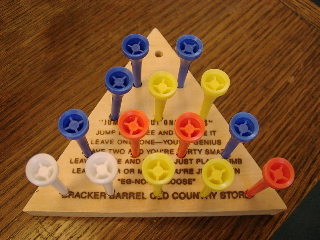
Please take advantage of the scheduled lab hours to make progress on PS3.
;;; A board is a pair of the number of rows and the empty squares
(define (make-board rows holes) (cons rows holes))
(define (board-holes board) (cdr board))
(define (board-rows board) (car board))
;;; A position is a pair of a row and column.
;;;
;;; make-position creates an row, col coordinate that
;;; represents a position on the board
;;; e.g. 1,1
;;; 2,1 2,2
;;; 3,1 3,2 3,3
(define (make-position row col) (cons row col))
(define (get-row posn) (car posn))
(define (get-col posn) (cdr posn))
(define (same-position pos1 pos2)
(and (= (get-row pos1) (get-row pos2))
(= (get-col pos1) (get-col pos2))))
Define a procedure on-board? that takes as inputs a board and a
position, and outputs true if and only if the position is on the board.
Define a procedure remove-peg that takes as input a board and a position, and produces as output the board with the peg at the input positition removed.
(define (remove-peg board posn)
(make-board (board-rows board)
_______________________))
Define a procedure add-peg that takes as input a board and a
position, and produces as output the board with a peg added at the input
positition. (Hint: this is much tougher.)
Next, try to solve as much of the problem as you can. You should first think about how to simulate a jump on the board. Then, consider how to find all the possible jumps on a given board. Finally, consider how to search all the possible sequences of jumps to find a winning sequence.
Good luck! And remember, even if you leave two pegs, "you're purty smart".

[an error occurred while processing this directive]